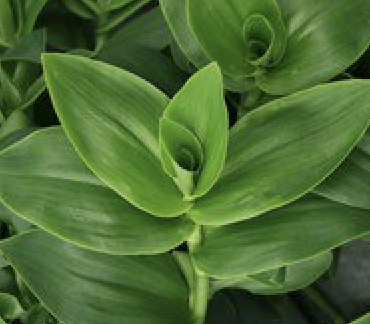
On Sanctuary Mountain Maungatautari the work to protect our native wildlife also involes understanding the native flora they live on.
And just as there is an ongoing battle to keep out the introduced mammals which see Maungatautari as a free lunch, so so the work continues to stave off invaise plantlife.
We ask Sanctuary Mountain chief executive Phil Lyons for a list of the five most problematice plants his team deals with.
And with the held of the Weedbusters website we profile them.
You will find more at weedbusters.org.nz – including information about two that just missed out on the list – Taiwanese cherry and Himalayan honey suckle.

Tradescantia
Also known as
Wandering willie
Where is it originally from?
South America
What does it look like?
Trailing, soft, hairless, perennial groundcover with succulent, soft, creeping stems that root at all nodes touching the ground. Dark green, shiny, smooth and slightly fleshy leaves (3-6 cm long ) are oval with pointed tips. White flowers (2 cm diameter, Dec-Jan) are 3-petalled and in small clusters. No fruit or seed is produced in New Zealand. Variegated and purple-backed leaf cultivars are common and revert readily to the green form.
Why is it weedy?
Creeping, mat-forming habit and rapid establishment from fragments. Very tolerant of dense shade, severe damage and grazing, wet, most soil types and high to low temperature, but not frost and drought.
How does it spread?
Stem fragments spread by water movement, livestock, dumped vegetation, soil movement, boots and mowers.
What damage does it do?
Smothers ground in light to deep shade, preventing the seedlings of native species from establishing. Causes habitats to open and be invaded by exotic shrubs and vines. Mats growing on riverbanks can break away with water flow and contribute to flooding.
What can I do to get rid of it?
Work down catchment from top and sides.
Rake and roll up (usually small spots only, to minimise initial spray). Best in drought period. Work towards centre. Dispose of at a refuse transfer station, burn or bury. Usually spray follow up

African Club moss
Also known as
Selaginella
Where is it originally from?
Southern and tropical Africa
What does it look like?
Small, carpet-forming, fern ally groundcover with long, fine roots and creeping, slender, irregularly branched stems that root at nodes. Leaves (2-4 mm) are in rows. Spore cones (10 mm long) are rounded.
Why is it weedy?
Disperses widely and quickly and grows on ground or on the trunks of other plants. Tolerates hot or cold, and light to deep shade, but requires reasonably damp to wet substrate.
How does it spread?
Spores and stem fragments are spread on boots, by livestock, water movement and dumped vegetation and in contaminated soil. Tracks, streams, contaminated plants and potting mix in nurseries and shops, and gardens are all sources of new infestations.
What damage does it do?
Invades forest floor, inhibiting the establishment of native plant seedings, leading to higher light levels and succession by more aggressive weeds, especially vines, a classic example of a small impact leading to a catastrophic outcome.
What can I do to get rid of it?
Pull out very small areas. Dispose of at a refuse transfer station, burn or bury deeply.

Blackberry
Also known as
Bramble, Rubus laciniatus, cut-leaved blackberry, many Rubus synonyms
Where is it originally from?
Northern temperate regions.
What does it look like?
Scrambling, very thorny, semi-erect shrub that is usually deciduous, with large root crowns and long suckers. Stems arching, entangled, green or red and occasionally taking root when in contact with the ground. Variously shaped (usually cut-edged), flat leaves are arranged alternately on the stems. White to pink 5-petalled flowers (November-April) followed by clusters of black berries (November-May).
Why is it weedy?
Forms dense, long-lived clumps, scrambles over the ground and low plants, has an extensive rhizome system, occasionally layering and seeding. Tolerates most soil types, drought and flood but is intolerant of dense shade.
How does it spread?
Mostly spread by rhizomes. Birds distribute seeds but they have a low germination rate.
What damage does it do?
Low to moderate damage in open habitats. Smothers most low growing species, inhibiting the establishment of native plant seedings, and impedes access.
What can I do to get rid of it?
Dig out small patches (all year round). Dispose of root crowns and rhizomes at a refuse transfer station or burn or bury deeply.

Pampas
Also known as
Cutty grass, Prince-of-Wales feathers
Where is it originally from?
South America
What does it look like?
Large-clump-forming grass. Leaf base is smooth or sparsely hairy. Leaves are blueish-green above and dark green below, have a conspicuous midrib, and snap readily when tugged. Dead leaf bases spiral like wood shavings. Erect, dense, fluffy, white-pinkish flowerheads (January to June) fade to a dirty white as seed forms.
Why is it weedy?
Tolerates heat and frost, salt, wind, wet and drought, moderate-shade, most soils, low fertility, and recovers quickly after fire. Massive amounts of well dispersed seed are produced.
How does it spread?
Seeds are spread very long distances by wind and occasionally water. Common seed sources are plantation forests, roadsides, farm hedges, quarries, and wasteland.
What damage does it do?
Colonises sprayed, burnt, slipped and otherwise disturbed sites and quickly becomes dense. Replaces groundcovers, shrubs, and ferns, creates fire hazards, provides habitats for possums and rats, and impedes access. Normally followed by weedy vines.
What can I do to get rid of it?
Establish that the species is not toetoe (look for erect seed heads in autumn). Dig or grub out seedlings or small plants. Chainsaw small plants and remove sizeable plants by bulldozer. Compost or leave on site to rot down. Burn or bury any flowerheads.

Crack willow
Where is it originally from?
Northern temperate regions
What does it look like?
Deciduous tree, under 25 metres, occasionally only shrub size, with spreading rather than hanging branches, and rough and fissured bark. Lance-shaped leaves with tiny serrations are bluish underneath and the upper surface is shiny and often covered with bright red galls. Narrow downward curving catkins appear at the same time or after the leaves, from September to October. As there are only male plants in New Zealand, no fruit is formed. Crack Willow and Grey Willow can be troublesome.
Why is it weedy?
Resprouting and suckering habit and rapid growth creates dense thickets. Tolerates flooding, hot to cold, most soils, and semi-shade.
How does it spread?
Stem fragments are spread by water, and suckers spread locally. Planted intentionally on stream and river banks and also in damp places to absorb water.
What damage does it do?
Replaces native species in riparian sites and forms vast, dense stands along channels. Causes blockages, flooding and structural changes in waterways.
What can I do to get rid of it?
Begin control at top of catchment, treat every stem.








